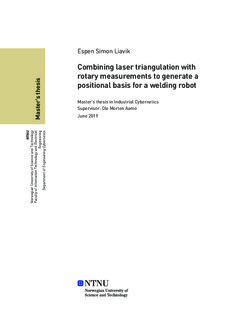| dc.contributor.advisor | Aamo, Ole Morten | |
| dc.contributor.advisor | Tingelstad, Lars | |
| dc.contributor.author | Liavik, Espen | |
| dc.date.accessioned | 2019-10-31T15:12:16Z | |
| dc.date.issued | 2019 | |
| dc.identifier | no.ntnu:inspera:35771502:23283525 | |
| dc.identifier.uri | http://hdl.handle.net/11250/2625736 | |
| dc.description.abstract | Bedriften WellConnection Monstad rapporterer at en tidskrevende sveise-prosess av roterende borerør forårsaker en flaskehals i produksjonslinjen deres. Etter et ønske om å fjerne denne flaskehalsen, vil bedriften undersøke muligheten for å få denne prosessen automatisert ved å benytte en sveiserobot. Dersom en robot skal kunne utføre en slik oppgave på automatisert vis, må den kunne forsynes med informasjon relatert til borerørets geometri. Av denne grunn er fokuset til denne oppgaven å utforske en metode som kan bli brukt til å skanne de roterende borerørene for å generere den nødvendige dataen som videre kan bli brukt for å skape en posisjonsreferanse.
Tilnærmingen til denne oppgaven har vært å kombinere datasyn med en måling av borerørets orientasjon, slik at rørets kurvatur er kjent for enhver orientasjon. Innen datasyn har denne oppgaven brukt lasertriangulering som en metode for å kunne måle rørets kurvatur. Denne metoden består av en laserprojektor og et kamera, og er en ofte brukt metode for å utrykke formen av et objekt i tredimensjonale koordinater.
Ettersom forholdet mellom laserprojektoren og kameraet er meget viktig innen lasertriangulering, har oppgaven også tatt for seg en metode som identifiserer dette forholdet. Dette ble gjort ved å generere en punktsky av punkter lokalisert i laserens plan, hvor laserplanet deretter ble estimert ved bruk av forskjellige planestimerings-metoder. Resultatene fra de forskjellige metodene ble deretter testet i sin nøyaktighet ved å måle kjente dimensjoner langs et objekt. Det mest nøyaktige planet ble estimert ved å bruke vekting av punktene i punktskyen, hvor vektene ble kalkulert etter hvor mye usikkerhet som var knyttet til de forskjellige punktene.
For å få tilgang til en orientasjonmåling ble det brukt en rotasjonsenkoder tilkoblet en Arduino via en analog-digital konverter. Når denne målingen ble kombinert med målingene fra lasertrianguleringen, ble et 3D-printet sylindrisk objekt skannet. Objektet ble rotert både med og uten kast, hvor den resulterende dataen videre ble illustrert ved å generere punktskyer. Den endelige representasjonen demonstrerte objektets kurvatur som en funksjon av orientasjon, og ble brukt til å illustrere hvordan robotens bane kunne bli kalkulert. Dette ble gjort for en av objektets seksjoner, og viste et høyt samsvar med objektets planlagte kast. | |
| dc.description.abstract | The company WellConnection Mongstad reports that a time-consuming welding process of rotating drill-pipes causes a bottleneck within their production line. In order to remove this bottleneck, the company desires to look in to the possibility of automating this process with the use of a welding robot. However, if a robot is to perform such a task automatically, it needs to be provided information regarding the geometry of the drill-pipes. Consequently, the focus of this thesis was to explore a method which can be used to scan the rotating drill-pipes which supplies the data needed to calculate a positional reference.
The approach of the thesis has been to combine computer vision with a measurement of the pipe's orientation, such that the curvature of the pipe is known for any given orientation. With regards to computer vision, this thesis specifically uses laser triangulation as a method for capturing the curvature. This method composes a laser-projector and a camera, which is a vastly used method for expressing an objects shape in three dimensional coordinates.
As the relationship between the laser projector and the camera is essential in laser triangulation, the thesis has also explored a method for identifying this relationship. This was achieved by generating a pointcloud of points located at the plane of the laser, from where the laserplane was estimated by using different plane fitting methods. As the planes were estimated, they were tested in their accuracy by calculating known dimensions of an object. Moreover, the best accuracy was achieved when weights was applied to the points which corresponded to their positional uncertainty.
In order to provide an orientational measurement a rotary encoder was connected to an Arduino using an analog-digital converter. As the measurement of orientation was combined with the reading from the laser triangulation, a 3D-printed cylindrical object was used as a test-subject for the scanning process. The object was rotated in both a centric and non-centric fashion, from where the data of the scan was presented in terms of point-clouds. The final representation illustrates the curvature of the object as a function of its orientation. This representation was used in order to demonstrate how the welding robots path could be estimated. When applied to one of the objects grooves, the estimated path demonstrated a high degree of correspondence to the rotational offset of the object. | |
| dc.language | eng | |
| dc.publisher | NTNU | |
| dc.title | Combining laser triangulation with rotary measurements to generate a positional basis for a welding robot | |
| dc.type | Master thesis | |
